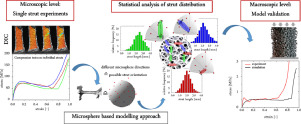当前位置:
X-MOL 学术
›
Mech. Mater.
›
论文详情
Our official English website, www.x-mol.net, welcomes your
feedback! (Note: you will need to create a separate account there.)
Multiscale microsphere modelling of open-cell metal foams enriched by statistical analysis of geometric parameters
Mechanics of Materials ( IF 3.4 ) Pub Date : 2020-03-01 , DOI: 10.1016/j.mechmat.2019.103295 T. Bleistein , M. Reis , X. Cheng , C. Redenbach , S. Diebels , A. Jung
Mechanics of Materials ( IF 3.4 ) Pub Date : 2020-03-01 , DOI: 10.1016/j.mechmat.2019.103295 T. Bleistein , M. Reis , X. Cheng , C. Redenbach , S. Diebels , A. Jung

|
Abstract Tailored design of application-optimised foam components requires the prediction of the mechanical properties by a numerical simulation model. Simulations that are able to account for microstructural changes are very time-consuming and not efficient. Hence, scale-bridging must be applied between the application-specific macroscale and the microscale or mesoscale accounting for structural variations in the pore or strut geometry. The present contribution deals with an innovative microsphere model considering uniaxial microtensile and microcompression experiments on individual struts as 1D constitutive laws for the microsphere model. This model is complemented by a statistical analysis of a real foam geometry and generalises the constitutive 1D models to a macroscopic 3D model taking the microstructure into account. The model was successfully validated by macroscopic experiments. The validation shows the potential of the model to predict the macroscopic behaviour of the foam using only data at the microscopic level. Thus expensive experiments on complete components can be reduced.
中文翻译:

通过几何参数的统计分析对开孔金属泡沫进行多尺度微球建模
摘要 应用优化泡沫部件的定制设计需要通过数值模拟模型预测机械性能。能够解释微观结构变化的模拟非常耗时且效率低下。因此,必须在特定应用的宏观尺度和微观尺度或中尺度之间应用尺度桥接,以解释孔隙或支柱几何结构的结构变化。目前的贡献涉及一种创新的微球模型,该模型将单个支柱上的单轴微拉伸和微压缩实验作为微球模型的一维本构法则。该模型通过对真实泡沫几何形状的统计分析进行补充,并将本构 1D 模型推广到考虑微观结构的宏观 3D 模型。该模型通过宏观实验成功验证。验证表明该模型有潜力仅使用微观层面的数据来预测泡沫的宏观行为。因此可以减少对完整组件进行昂贵的实验。
更新日期:2020-03-01
中文翻译:

通过几何参数的统计分析对开孔金属泡沫进行多尺度微球建模
摘要 应用优化泡沫部件的定制设计需要通过数值模拟模型预测机械性能。能够解释微观结构变化的模拟非常耗时且效率低下。因此,必须在特定应用的宏观尺度和微观尺度或中尺度之间应用尺度桥接,以解释孔隙或支柱几何结构的结构变化。目前的贡献涉及一种创新的微球模型,该模型将单个支柱上的单轴微拉伸和微压缩实验作为微球模型的一维本构法则。该模型通过对真实泡沫几何形状的统计分析进行补充,并将本构 1D 模型推广到考虑微观结构的宏观 3D 模型。该模型通过宏观实验成功验证。验证表明该模型有潜力仅使用微观层面的数据来预测泡沫的宏观行为。因此可以减少对完整组件进行昂贵的实验。











































 京公网安备 11010802027423号
京公网安备 11010802027423号